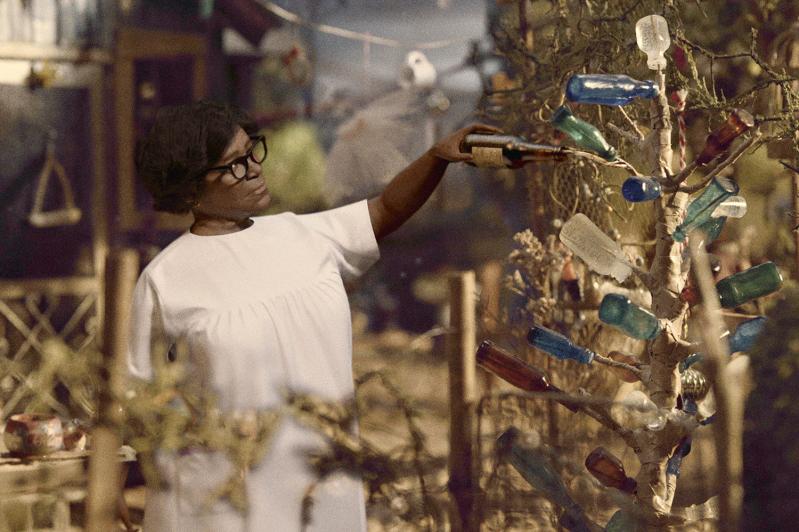Nellie Mae Rowe was born in Fayetteville, Ga., in 1900. One of 10 children, she left school after the fourth grade to work in the cotton fields with her father, who had once been enslaved.
In 2021, the exhibition "Really Free: The Radical Art of Nellie Mae Rowe" opened at the High Museum of Art in Atlanta and traveled the following year to the Brooklyn Museum. "Altogether, it propels Rowe's art into the upper echelons of the self-taught canon . . . " Roberta Smith of The New York Times said in her review.
How Rowe, a self-taught artist who died in 1982, went from Fayetteville to art world acclaim is the story of "This World Is Not My Own," a documentary directed by Petter Ringbom and Marquise Stillwell that is being shown in the Hamptons International Film Festival. Mr. Ringbom, who has a house on Shelter Island, said last week that their ambition was to make a film "that would, hopefully, transcend the art documentary silo."
"The creative challenge that we realized quite early on," he explained, "was that we were making a film about someone who had been dead for 40 years, and where there wasn't that rich archival treasure you can dig into to create a story."
The film opens with the camera panning down from the sky to a Black woman sweeping in front of a cottage whose yard is filled all manner of objects, among them Christmas ornaments, handmade dolls, plastic fruit, a bottle tree. She talks to the camera about being ready to fly up when God calls her. As she says she's having a hard time "down here," a truck whizzes by and flings a bottle into her yard.
An unsuspecting viewer might have a hard time determining whether or not the scene is real. A tree's leaves look more like cotton candy, and there's something strangely stylized about the woman.
"How do you get someone to connect to this person emotionally?" Mr. Ringbom said. "We thought, let's imagine she was alive. And that we were filming her as if she was alive, and try to create a character that reimagines her."
The filmmakers turned to 3D animation built upon motion-capture work, with Uzo Aduba ("Orange Is the New Black"), who plays Rowe. Those scenes are interwoven with interviews and historical material, including actual black-and-white film footage of the artist.
They reconstructed the exterior and interior of Rowe's house, which during the 21st-century gentrification of her neighborhood was replaced by a hotel. She called it her "playhouse," which she decorated with found-object installations, handmade dolls, chewing-gum sculptures, and hundreds of drawings and mixed-media works.
Another component of the story is the connection between Rowe and Judith Alexander, the daughter of a wealthy Georgia attorney who ran an eponymous gallery in Atlanta.
Alexander first saw Rowe's work in a 1976 exhibition at the Atlanta Historical Society. Smitten, she gave the artist a solo show at the Alexander Gallery and in 1978 secured her an exhibition with Betty Parsons in New York City.
One untitled work of Rowe's from 1978-82 depicts two conjoined, almost identical houses that signify the linked destinies of the artist and Alexander. The composition features the vibrant colors and stylized landscape and architecture typical of Rowe's work.
Another untitled crayon and pencil drawing that shows Rowe riding a chicken exemplifies how she married human, plant, and animal forms in her work. The chicken's face consists in part of a tree whose branches create its eyes and hair.
Rowe's story is told in the film by many relatives, including Roberta Bates, a great-niece, and Cathi Perry, a great-great niece. Maurice J. Hobson, an African-American writer and historian, places Rowe in the larger social-political context of Georgia from the turn of the century to the civil rights movement.
The Judith Alexander Foundation in Atlanta approached the filmmakers in 2016 to make a film on Rowe and her work. Ms. Perry is the president of the foundation, which provided seed funding for the film but gave the filmmakers full creative control.
In the end, what links all the moving parts of the film is Rowe's art. We see dolls and other eccentric creations, but it is the paintings, with their flat figures, lack of perspective, exuberant colors, variations in scale, and dazzling compositions that are its beating heart.
In part because Mr. Ringbom is originally Swedish, the film is being released in that country at the same time it is showing here in the film festival. It will be in festivals through the end of the year; the filmmakers are looking to 2024 for release in the United States.
"This World Is Not My Own" will be shown Saturday in Sag Harbor and on Wednesday in East Hampton. Mr. Stillwell will attend the first screening, Mr. Ringbom the second.




